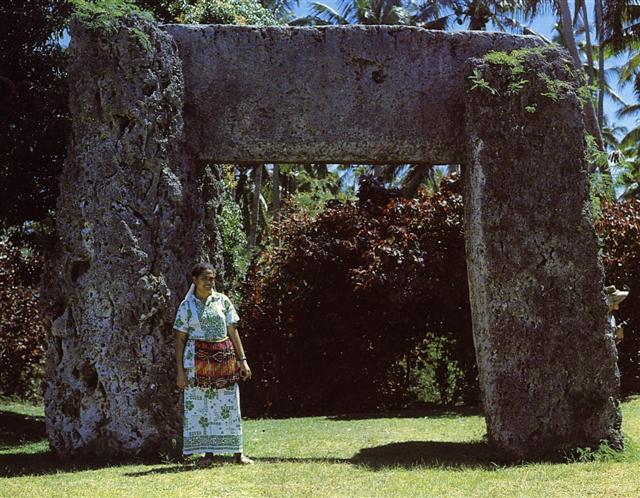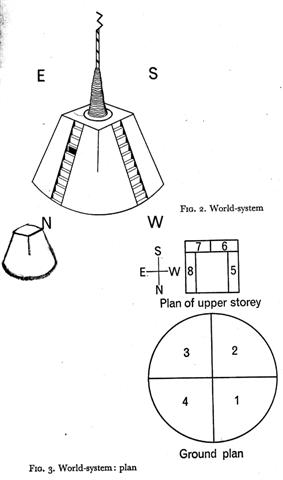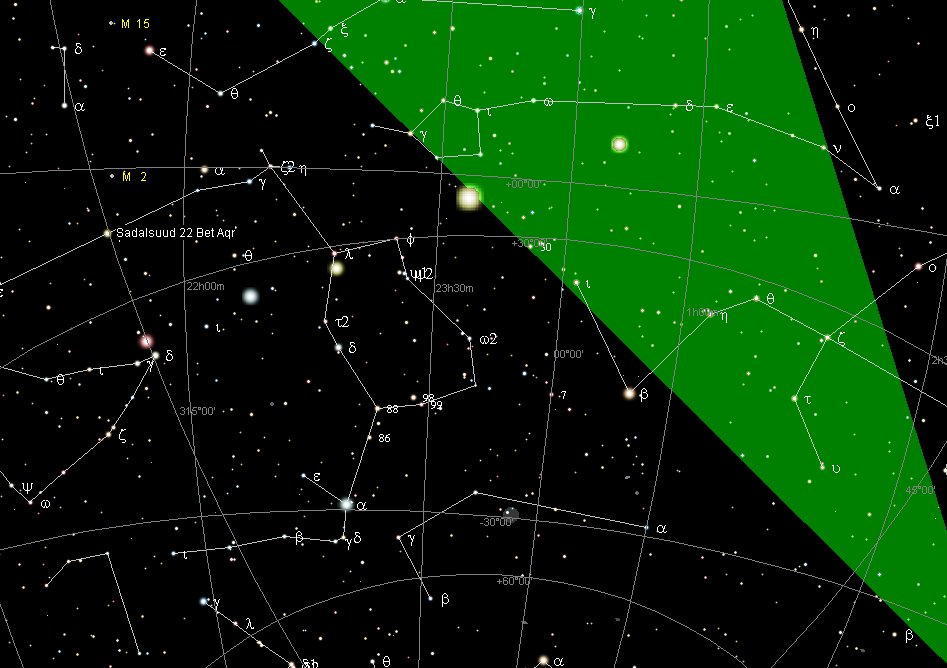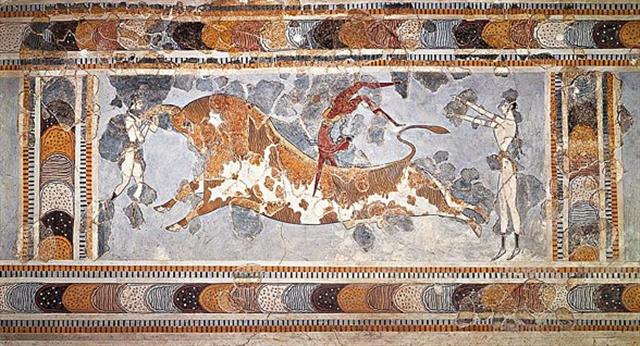63. We should document more of the croquet ground, in order to reveal more difficulties:
In a cycle you could begin anywhere, but the culmination of Sirius seems to be a good place:
The difference in glyph numbers ought to correspond to the difference in right ascension days, for instance could we expect the stars at Gb2-27 to be 17 days later than those at Gb2-10 (265):
We can indeed count: δ Piscis Austrini (347.4) - ι Piscis Austrini (329.4) = 18.0 = Gb2-28 - Gb2-10. The fraction .4 should be used in order to secure the counting. The problematic place in the day after Gb2-5 (260) will not disturb counting from Gb2-10 to Gb2-27. ... All was now ready for departure except that there was no fire in the smithy. The ancestor slipped into the workshop of the great Nummo, who are Heaven's smiths, and stole a piece of the sun in the form of live embers and white-hot iron. He seized it by means of a 'robber's stick' the crook of which ended in a slit, open like a mouth. He dropped some of the embers, came back to pick them up, and fled towards the granary; but his agitation was such that he could no longer find the entrances. He made the round of it several times before he found the steps and climbed onto the flat roof, where he hid the stolen goods in one of the skins of the bellows, exclaiming: 'Gouyo!', which is to say. 'Stolen!'. The word is still part of the language, and means 'granary'. It is a reminder that without the fire of the smithy and the iron of hoes there would be no crops to store ...
Fomalhaut at DECEMBER 29 (Gb2-28, 363 → 3 * 121) - 18 = DECEMBER 11 (345 → 15 * 23) at Deneb Algiedi, - which latter place in March 14 (3-14) AD 2024 (Π) should be a place for the planet Mars:
And "January 20 (365 + 20 = 385, *305) - "January 3 (368, *288) = *17 → 136 (→ Alcyone in the Pleiades) / 8. ... Ogotemmêli had his own ideas about calculation. The Dogon in fact did use the decimal system, because from the beginning they had counted on their fingers, but the basis of their reckoning had been the number eight and this number recurred in what they called in French la centaine, which for them meant eighty. Eighty was the limit of reckoning, after which a new series began. Nowadays there could be ten such series, so that the European 1,000 corresponded to the Dogon 800. But Ogotemmêli believed that in the beginning men counted by eights - the number of cowries on each hand, that they had used their ten fingers to arrive at eighty, but that the number eight appeared again in order to produce 640 (8 x 10 x 8). 'Six hundred and forty', he said, 'is the end of the reckoning.' 5 days after Fomalhaut was Φ Aquarii (*352.0). Such stars which against the background of my assumed era for rongorongo were at natural (whole) right ascension day numbers might have played influential roles. ... Nut, whom the Greeks sometimes identified with Rhea, was goddess of the sky, but it was debatable if in historical times she was the object of a genuine cult. She was Geb's twin sister and, it was said, married him secretly and against the will of Ra. Angered, Ra had the couple brutally separated by Shu and afterwards decreed that Nut could not bear a child in any given month of any year. Thoth, Plutarch tells us, happily had pity on her. Playing draughts with the Moon, he won in the course of several games a seventy-second part of the Moon's light with which he composed five new days. As these five intercalated days did not belong to the official Egyptian calendar of three hundred and sixty days, Nut was thus able to give birth successively to five children: Osiris, Haroeris (Horus), Set, Isis and Nepthys ...:
From the illustration of Hevelius we can see that Φ Aquarii is preceded on the path of the ecliptic plane by λ (*346.5), also named 73 Aquarii. In my picture below (for the evening of April 14 AD 2014) this star is visible just outside the left hand border.
According to Cartes du Ciel there should be a line connecting the Aquarius constellation with Fomalhaut and the constellation of the Southern Fish. The arrow of time seems to be reversed here, possibly due to how the synodic orbit of Mars sometimes goes withershins (will be retrograde → réculer pour mieux sauter).
... What interests me most in conducting this argument is the difference that is constantly appearing between the poetic and prosaic methods of thought. The prosaic method was invented by the Greeks of the Classical age as an insurance agains the swamping of reason by mythographic fancy. It has now become the only legitimate means of transmitting useful knowledge. And in England, as in most other mercantile countries, the current popular view is that 'music' and oldfashioned diction are the only characteristics of poetry which distinguish it from proses: that every poem has, or should have, a precise single-strand prose equivalent. As a result, the poetic faculty is atrophied in every educated person who does not privately struggle to cultivate it: very much as the faculty of understanding pictures is atrophied in the Bedouin Arab. (T. E. Lawrence once showed a coloured crayon sketch of an Arab Sheikh to the Sheikh's own clansmen. They passed it from hand to hand, but the nearest guess as to what it represented came from a man who took the sheikh's foot to be the horn of a buffalo.) And from the inability to think poetically - to resolve speech into its original images and rhythms and re-combine these on several simultaneous levels of thought into a multiple sense - derives the failure to think clearly in prose. In prose one thinks on only one level at a time, and no combination of words needs to contain more than a single sense; nevertheless the images resident in words must be securely related if the passage is to have any bite. This simple need is forgotten, what passes for simple prose nowadays is a mechanical stringing together of stereotyped word-groups, without regard for the images contained in them. The mechanical style, which began in the counting-house, has now infiltrated into the university, some of its most zombiesque instances occurring in the works of eminent scholars and divines ... Playing with numbers we could say that 780 (synodic orbit of Mars) = 3 * 260 (the Mayan tzolkin) = 60 * 13 = 26 * 30 = 20 * 39 And from there: 3 * 360 = 1080 = 780 + 300. In other words we could perceive a pattern which predicts a return of Mars about 300 days earlier (= 60 days later) for every 3rd year. *352.0 (Φ Aquarii) → *292 + *60. April 14 AD 2014 (360 + 104 = 464) → 404 + 60. 404 - 292 = 112 = 4 * 28 = 8 fortnights.
But perhaps the Martian hedgehog would here unroll itself and walk away:
|
|||||||||||||||||||||||||||||||||||||||||||||||||||||||||||||||||||||||||||||||||||||||||||||||||||||||||||||||||||||||||||||||||||||||||||||||||||||||||||||||||||||||||||||||||||||||||||||||






















